The Impact of Government Interventions and Consumer Green Preferences on the Competition between Green and Nongreen Supply Chains
Abstract
:1. Introduction
- How do the NGSC and the GSC interact with each other in the centralized and decentralized decision models? Which decision model is more beneficial for GSCs?
- How do the preferences of consumers for green products affect the product pricing and the profits of NGSCs and GSCs?
- What is the impact of government subsidies for green products and taxes for nongreen products on the pricing and profits of NGSCs and GSCs? Will it improve the competitiveness of GSCs?
- Given the coexistence of various factors (parameters), which factors have the most significant effects on the profits of NGSCs and GSCs?
2. Literature Review
2.1. Competition of Supply Chain
2.2. Government Interventions in Supply Chain
2.3. Influence of Consumer Preferences
2.4. Research Gap
3. Problem Description
4. The Model Formulation
4.1. Centralized Decision Model
4.2. Decentralized Decision Model
4.3. Comparisons of Centralized and Decentralized Decision Models
- (i)
- When, , otherwise;
- (ii)
- When, , otherwise.
4.4. Comparisons of the NGSC and the GSC
- (i)
- When,, otherwise;
- (ii)
- When,, otherwise.
- (i)
- When,, otherwise;
- (ii)
- When,, otherwise;
- (iii)
- When,, otherwise;
- (iv)
- When,, otherwise;
- (v)
- When,, otherwise.
- Consumer green preferences. In the actual market, the consumer environmental awareness is poor at the beginning, and thus consumers show less interest in green products, and they are more likely to purchase nongreen products on the basis of their consumption habits, which leads to an increase in the market demand for nongreen products. As a result, the sales prices of nongreen products go up (i.e., their marginal revenues increase), and then the entire profit of the NGSC grows. Nevertheless, the sales quantities of green products are relatively small. In order to improve their market competitiveness, the green manufacturer has to sell green products at a lower price than nongreen products. Meanwhile, the GSC needs to bear the investment costs of the green technology as well. All of these factors will result in less profit for the entire GSC. As the consumer awareness of environmental protection rises, consumer preferences for green products will increase, and, thus, the market demand for green products will accelerate. However, nongreen products have to be sold at lower prices to seize the market. Accordingly, there comes a reduction in the marginal revenues of nongreen products, and shrinkage in the profits of the entire NGSC;
- Government interventions. Under the condition that the subsidy rates for green products are high, there will be some subsidies that will be transferred to consumers eventually (i.e., the sales prices of green products will fall), whereas the sales prices of nongreen products will still be kept unaltered because of the lack of subsidies. Thus, there will be a situation in which the sales prices of the NGSC are lower than those of the GSC. In the case that the government imposes higher tax rates on nongreen products, the nongreen manufacturer will have to raise the sales prices to maintain profitability so as to compensate for the losses that are caused by the taxation, which means that the tax will finally be transferred to the consumers, while the sales prices of the green products will not be increased because of the absence of additional tax costs. Hence, they are lower than the sales prices of nongreen products. This is in accordance with the famous Porter hypothesis, which states that appropriate environmental regulations can stimulate firms to carry out green-technology innovation so as to build a competitive advantage in the market [77]. To conclude, the government subsidies and taxes on products pertain to forms of environmental regulations, and they can encourage green manufacturers to implement eco-innovation actively in order to enhance the market competitiveness of green products.
5. Sensitivity Analysis
5.1. Sensitivity Analysis of a Single Parameter
5.1.1. Consumer-Green-Preference Coefficient
5.1.2. Government Subsidy Rate for Green Products
5.1.3. Government Tax Rate for Nongreen Products
5.1.4. Green-Technology-Investment-Cost Coefficient
- For the government that wants to intervene in the market and enhance the sustainability of products, it needs to impose taxes on nongreen products when providing subsidies for green products (i.e., the two policies should be carried out at the same time). Then, they will really work in short order under the conditions of the market economy;
- The manufacturers in the GSC need to continue to invest more in the R&D of green production for the purposes of obtaining greater competitiveness and more benefits. Moreover, they do not need to worry about the situation that their profits will be greatly reduced because of the increase in the green-technology-investment costs;
- The enterprises in the GSC need to put lots of effort into improving consumer cognition and the consumption consciousness of green products. They can achieve that through the power of the market and through some media resources, such as sustainability reporting, green advertising, and green branding [78,79].
5.2. Robust Sensitivity Analysis of Multiple Parameters
- When the parameters of the ,,, and are all at Level 1, the profit that corresponds to the manufacturer and the retailer in the NGSC in the decentralized scenario is the largest;
- When the parameters of the ,,, and are at Level 2, Level 1, Level 1, and Level 2, respectively, the largest profit response to the manufacturer and the retailer in the GSC under the decentralized decision model can be obtained;
- Figure 15a,b indicates that the most favorable conditions for the manufacturer and the retailer in the NGSC are when the , , , and are all at Level 1, which helps them to gain more revenue. The and the have lower effects on their profits, while the has the greatest effect, followed by the ;
- Figure 15c,d depicts that the most advantageous conditions for the manufacturer and the retailer in the GSC are the at Level 2, the at Level 1, the at Level 1, and the at Level 2. In this state, the green manufacturer and the retailer easily obtain more revenues. For the green retailer, the has a lower influence, and the , , and have greater influences. Contrary to this, for the green manufacturer, the has a lower effect. Among the four factors, the plays the most important role in the profits of the manufacturer and the retailer in the GSC.
- In the competitive market, the manufacturers and retailers in the GSC should focus on the green preferences of consumers, and they should enhance the green awareness of consumers by way of encouraging them to learn more about the advantages and environmental attributes of green products through publicity;
- The manufacturers in the GSC should cut down the investment expense of the green-technology level in order to boost competitiveness. For the manufacturers and retailers in the NGSC, the only way to have a place in the market is to reduce the production costs.
6. Conclusions
- (i)
- The higher the government subsidy rate for green products, the more revenue the GSC obtains. The lower the tax rate for nongreen products, the more profits the NGSC obtains. When the two measures are implemented at the same time, the effect is more obvious. Therefore, it is necessary for the government to implement intervention policies for green and nongreen products simultaneously, so as to enhance the competitiveness of green products more rapidly and effectively;
- (ii)
- In the centralized and decentralized decision models, when the parameters (i.e., the subsidy rate, the tax rate, and the consumer-green-preference coefficient) meet the premeditated threshold, the sales prices and the wholesale prices of the GSC will be lower, and its members will gain more benefits (namely, the GSC will become more competitive than the NGSC);
- (iii)
- Under the influence of government interventions and the green preferences of consumers in the centralized scenario, the green-technology level is higher and the sales price is lower; that is, it is conducive to improving the greenness and the sustainability of products, and to bringing more benefits to consumers. However, there will be a situation where the overall profits of the NGSC and the GSC in the centralized scenario are less than those in the decentralized scenario; that is, the cooperation between the manufacturers and retailers does not necessarily increase the total profits of the NGSC and the GSC in this case;
- (iv)
- The consumer-green-product-preference coefficient is the most important factor for the profits of GSCs. The green-technology-investment-cost coefficient shows a significant impact on the profits of the NGSC. As a consequence, the strengthening of the consumer awareness of environmental protection and cutting down green investment costs will help to improve the sustainability of products in a rapid amount of time.
Author Contributions
Funding
Institutional Review Board Statement
Informed Consent Statement
Data Availability Statement
Conflicts of Interest
Abbreviations
| Parameters | |
| Unit manufacturing cost of product (, ) | |
| Consumer demand for product (, ) | |
| Market base demand | |
| Price-elasticity parameter of demand | |
| Cross-price-elasticity parameter of demand | |
| Green-technology-level elasticity parameter of demand | |
| Consumer-green-preference coefficient | |
| Green-technology-investment-cost coefficient of the manufacturer | |
| Subsidy rate for the unit green product given by the government | |
| Tax rate for the unit nongreen product levied by the government | |
| Decision variables | |
| Unit retail price of product (, ) | |
| Unit wholesale price of product () from the manufacturer to the retailer () | |
| Green-technology level of the manufacturer | |
| Objective functions | |
| Total profit for the product () system in the centralized decision model () | |
| Total profit for the retailer () in the decentralized decision model () | |
| Total profit for the supplier () in the decentralized decision model () | |
Appendix A
References
- Toptal, A.; Çetinkaya, B. How supply chain coordination affects the environment: A carbon footprint perspective. Ann. Oper. Res. 2017, 250, 487–519. [Google Scholar] [CrossRef] [Green Version]
- Tong, W.; Mu, D.; Zhao, F.; Mendis, G.P.; Sutherland, J.W. The impact of cap-and-trade mechanism and consumers’ environmental preferences on a retailer-led supply Chain. Resour. Conserv. Recycl. 2019, 142, 88–100. [Google Scholar] [CrossRef]
- Liu, P.; Yi, S.P. Pricing policies of green supply chain considering targeted advertising and product green degree in the Big Data environment. J. Clean. Prod. 2017, 164, 1614–1622. [Google Scholar] [CrossRef]
- Seuring, S. A review of modeling approaches for sustainable supply chain management. Decis. Support Syst. 2013, 54, 1513–1520. [Google Scholar] [CrossRef]
- Pizer, W.A. Combining price and quantity controls to mitigate global climate change. J. Public Econ. 2002, 85, 409–434. [Google Scholar] [CrossRef]
- Hafezalkotob, A. Competition of domestic manufacturer and foreign supplier under sustainable development objectives of government. Appl. Math. Comput. 2017, 292, 294–308. [Google Scholar] [CrossRef]
- Madani, S.R.; Rasti-Barzoki, M. Sustainable supply chain management with pricing, greening and governmental tariffs determining strategies: A game-theoretic approach. Comput. Ind. Eng. 2017, 105, 287–298. [Google Scholar] [CrossRef]
- Luke, E. Firms get help in tracking EU green legislation. China Dly. 2005, 2, 2. [Google Scholar]
- Hall, J. Environmental supply chain dynamics. J. Clean. Prod. 2000, 8, 455–471. [Google Scholar] [CrossRef]
- Pujari, D. Eco-innovation and new product development: Understanding the influences on market performance. Technovation 2006, 26, 76–85. [Google Scholar] [CrossRef]
- Jabali, O.; Van Woensel, T.; De Kok, A.G. Analysis of Travel Times and CO2 Emissions in Time-Dependent Vehicle Routing. Prod. Oper. Manag. 2012, 21, 1060–1074. [Google Scholar] [CrossRef]
- Yang, H.; Chen, W. Retailer-driven carbon emission abatement with consumer environmental awareness and carbon tax: Revenue-sharing versus Cost-sharing. Omega 2018, 78, 179–191. [Google Scholar] [CrossRef]
- Bull, J. Loads of green washing—can behavioural economics increase willingness-to-pay for efficient washing machines in the UK? Energy Policy 2012, 50, 242–252. [Google Scholar] [CrossRef]
- Grimmer, M.; Bingham, T. Company environmental performance and consumer purchase intentions. J. Bus. Res. 2013, 66, 1945–1953. [Google Scholar] [CrossRef]
- Amacher, G.S.; Koskela, E.; Ollikainen, M. Environmental quality competition and eco-labeling. J. Environ. Econ. Manag. 2004, 47, 284–306. [Google Scholar] [CrossRef] [Green Version]
- Ibanez, L.; Grolleau, G. Can Ecolabeling Schemes Preserve the Environment? Environ. Resour. Econ. 2008, 40, 233–249. [Google Scholar] [CrossRef]
- Zhao, L.; Chen, Y. Optimal Subsidies for Green Products: A Maximal Policy Benefit Perspective. Symmetry 2019, 11, 63. [Google Scholar] [CrossRef] [Green Version]
- Lou, G.; Lai, Z.; Ma, H.; Fan, T. Coordination in a composite green-product supply chain under different power structures. Ind. Manag. Data Syst. 2020, 120, 1101–1123. [Google Scholar] [CrossRef]
- de Oliveira, U.R.; Espindola, L.S.; da Silva, I.R.; da Silva, I.N.; Rocha, H.M. A systematic literature review on green supply chain management: Research implications and future perspectives. J. Clean. Prod. 2018, 187, 537–561. [Google Scholar] [CrossRef]
- Hafezalkotob, A. Competition, cooperation, and coopetition of green supply chains under regulations on energy saving levels. Transp. Res. Part E: Logist. Transp. Rev. 2017, 97, 228–250. [Google Scholar] [CrossRef]
- Xiao, T.; Yang, D. Price and service competition of supply chains with risk-averse retailers under demand uncertainty. Int. J. Prod. Econ. 2008, 114, 187–200. [Google Scholar] [CrossRef]
- Meng, Q.; Li, M.; Liu, W.; Li, Z.; Zhang, J. Pricing policies of dual-channel green supply chain: Considering government subsidies and consumers’ dual preferences. Sustain. Prod. Consum. 2021, 26, 1021–1030. [Google Scholar] [CrossRef]
- Gao, J.; Xiao, Z.; Wei, H.; Zhou, G. Dual-channel green supply chain management with eco-label policy: A perspective of two types of green products. Comput. Ind. Eng. 2020, 146, 106613. [Google Scholar] [CrossRef]
- Stucki, T.; Woerter, M.; Arvanitis, S.; Peneder, M.; Rammer, C. How different policy instruments affect green product innovation: A differentiated perspective. Energy Policy 2018, 114, 245–261. [Google Scholar] [CrossRef]
- Xu, X.P.; Li, Y.; Luo, M.M.; Peng, Q. Recent progress towards fluorinated copolymers for efficient photovoltaic applications. Chin. Chem. Lett. 2016, 27, 1241–1249. [Google Scholar] [CrossRef]
- Feng, Y.; Xia, X.; Yin, X.; Wang, L.; Zhang, Z. Pricing and Coordination of Remanufacturing Supply Chain with Government Participation considering Consumers’ Preferences and Quality of Recycled Products. Complexity 2022, 2022, 8378639. [Google Scholar] [CrossRef]
- Mohammaditabar, D.; Ghodsypour, S.H.; Hafezalkotob, A. A game theoretic analysis in capacity-constrained supplier-selection and cooperation by considering the total supply chain inventory costs. Int. J. Prod. Econ. 2016, 181, 87–97. [Google Scholar] [CrossRef]
- Li, W.; Chen, J. Backward integration strategy in a retailer Stackelberg supply chain. Omega 2018, 75, 118–130. [Google Scholar] [CrossRef]
- Qi, Q.; Wang, J.; Bai, Q. Pricing decision of a two-echelon supply chain with one supplier and two retailers under a carbon cap regulation. J. Clean. Prod. 2017, 151, 286–302. [Google Scholar] [CrossRef]
- Bai, Q.; Jin, M.; Xu, X. Effects of carbon emission reduction on supply chain coordination with vendor-managed deteriorating product inventory. Int. J. Prod. Econ. 2019, 208, 83–99. [Google Scholar] [CrossRef]
- Mahmoudi, R.; Rasti-Barzoki, M. Sustainable supply chains under government intervention with a real-world case study: An evolutionary game theoretic approach. Comput. Ind. Eng. 2018, 116, 130–143. [Google Scholar] [CrossRef]
- Seyedhosseini, S.M.; Hosseini-Motlagh, S.M.; Johari, M.; Jazinaninejad, M. Social price-sensitivity of demand for competitive supply chain coordination. Comput. Ind. Eng. 2019, 135, 1103–1126. [Google Scholar] [CrossRef]
- Sana, S.S. Price competition between green and non green products under corporate social responsible firm. J. Retail. Consum. Serv. 2020, 55, 102118. [Google Scholar] [CrossRef]
- Nagurney, A.; Yu, M. Sustainable fashion supply chain management under oligopolistic competition and brand differentiation. Int. J. Prod. Econ. 2012, 135, 532–540. [Google Scholar] [CrossRef]
- Zhang, L.; Wang, J.; You, J. Consumer environmental awareness and channel coordination with two substitutable products. Eur. J. Oper. Res. 2015, 241, 63–73. [Google Scholar] [CrossRef]
- Li, X.; Li, Y. Chain-to-chain competition on product sustainability. J. Clean. Prod. 2016, 112, 2058–2065. [Google Scholar] [CrossRef]
- Yang, L.; Zhang, Q.; Ji, J. Pricing and carbon emission reduction decisions in supply chains with vertical and horizontal cooperation. Int. J. Prod. Econ. 2017, 191, 286–297. [Google Scholar] [CrossRef]
- Saha, S.; Nielsen, I. Strategic Integration Decision under Supply Chain Competition in the Presence of Online Channel. Symmetry 2020, 13, 58. [Google Scholar] [CrossRef]
- Hafezalkotob, A.; Hadi, T. Impact of government’s policies on competition of two closed-loop and regular supply chains. J. Ind. Syst. Eng. 2015, 8, 87–105. [Google Scholar]
- Hafezalkotob, A. Competition of two green and regular supply chains under environmental protection and revenue seeking policies of government. Comput. Ind. Eng. 2015, 82, 103–114. [Google Scholar] [CrossRef]
- Hadi, T.; Sheikhmohammady, M.; Chaharsooghi, S.K.; Hafezalkotob, A. Competition between regular and closed-loop supply chains under financial intervention of government; a game theory approach. J. Ind. Syst. Eng. 2021, 13, 179–199. [Google Scholar]
- Yazdanpanah, A.H.; Akbari, A.A.; Mozafari, M. A Game Theoretical Approach to Optimize Policies of Government Under the Cartel of Two Green and Non-Green Supply Chains. J. Optim. Ind. Eng. 2020, 12, 189–197. [Google Scholar]
- Nielsen, I.; Majumder, S.; Szwarc, E.; Saha, S. Impact of Strategic Cooperation under Competition on Green Product Manufacturing. Sustainability 2020, 12, 10248. [Google Scholar] [CrossRef]
- Hafezalkotob, A. Direct and indirect intervention schemas of government in the competition between green and non-green supply chains. J. Clean. Prod. 2018, 170, 753–772. [Google Scholar] [CrossRef]
- Hafezalkotob, A.; Alavi, A.; Makui, A. Government financial intervention in green and regular supply chains: Multi-level game theory approach. Int. J. Manag. Sci. Eng. Manag. 2016, 11, 167–177. [Google Scholar] [CrossRef]
- Hepburn, C. Regulation by Prices, Quantities, or Both: A Review of Instrument Choice. Oxf. Rev. Econ. Policy 2006, 22, 226–247. [Google Scholar] [CrossRef]
- Xu, X.; He, P.; Xu, H.; Zhang, Q. Supply chain coordination with green technology under cap-and-trade regulation. Int. J. Prod. Econ. 2017, 183, 433–442. [Google Scholar] [CrossRef]
- Wang, Q.; Zhao, D.; He, L. Contracting emission reduction for supply chains considering market low-carbon preference. J. Clean. Prod. 2016, 120, 72–84. [Google Scholar] [CrossRef]
- Sabzevar, N.; Enns, S.T.; Bergerson, J.; Kettunen, J. Modeling competitive firms’ performance under price-sensitive demand and cap-and-trade emissions constraints. Int. J. Prod. Econ. 2017, 184, 193–209. [Google Scholar] [CrossRef]
- Xu, X.; Zhang, W.; He, P.; Xu, X. Production and pricing problems in make-to-order supply chain with cap-and-trade regulation. Omega 2017, 66, 248–257. [Google Scholar] [CrossRef]
- Safarzadeh, S.; Rasti-Barzoki, M. A game theoretic approach for assessing residential energy-efficiency program considering rebound, consumer behavior, and government policies. Appl. Energy 2019, 233–234, 44–61. [Google Scholar] [CrossRef]
- He, P.; He, Y.; Xu, H. Channel structure and pricing in a dual-channel closed-loop supply chain with government subsidy. Int. J. Prod. Econ. 2019, 213, 108–123. [Google Scholar] [CrossRef]
- Nielsen, I.E.; Majumder, S.; Saha, S. Game-Theoretic Analysis to Examine How Government Subsidy Policies Affect a Closed-Loop Supply Chain Decision. Appl. Sci. 2019, 10, 145. [Google Scholar] [CrossRef] [Green Version]
- Niu, B.; Chen, L.; Zhang, J. Punishing or subsidizing? Regulation analysis of sustainable fashion procurement strategies. Transp. Res. Part E: Logist. Transp. Rev. 2017, 107, 81–96. [Google Scholar] [CrossRef]
- Li, J.; Liu, P. Modeling green supply chain games with governmental interventions and risk preferences under fuzzy uncertainties. Math. Comput. Simul. 2022, 192, 182–200. [Google Scholar] [CrossRef]
- Bask, A.; Halme, M.; Kallio, M.; Kuula, M. Consumer preferences for sustainability and their impact on supply chain management. Int. J. Phys. Distrib. Logist. Manag. 2013, 43, 380–406. [Google Scholar] [CrossRef]
- Kim, B.; Park, K.; Swink, M. Consumers’ preferences for facets of green supply chain management. Int. J. Serv. Oper. Manag. 2014, 18, 74–98. [Google Scholar] [CrossRef]
- Yu, Y.; Han, X.; Hu, G. Optimal production for manufacturers considering consumer environmental awareness and green subsidies. Int. J. Prod. Econ. 2016, 182, 397–408. [Google Scholar] [CrossRef] [Green Version]
- Sun, L.; Cao, X.; Alharthi, M.; Zhang, J.; Taghizadeh-Hesary, F.; Mohsin, M. Carbon emission transfer strategies in supply chain with lag time of emission reduction technologies and low-carbon preference of consumers. J. Clean. Prod. 2020, 264, 121664. [Google Scholar] [CrossRef]
- Ghosh, S.K.; Seikh, M.R.; Chakrabortty, M. Analyzing a stochastic dual-channel supply chain under consumers’ low carbon preferences and cap-and-trade regulation. Comput. Ind. Eng. 2020, 149, 106765. [Google Scholar] [CrossRef]
- Zhang, G.; Dai, G.; Sun, H.; Zhang, G.; Yang, Z. Equilibrium in supply chain network with competition and service level between channels considering consumers’ channel preferences. J. Retail. Consum. Serv. 2020, 57, 102199. [Google Scholar] [CrossRef]
- Yang, D.; Xiao, T. Pricing and green level decisions of a green supply chain with governmental interventions under fuzzy uncertainties. J. Clean. Prod. 2017, 149, 1174–1187. [Google Scholar] [CrossRef]
- Dong, C.; Shen, B.; Chow, P.S.; Yang, L.; Ng, C.T. Sustainability investment under cap-and-trade regulation. Ann. Oper. Res. 2016, 240, 509–531. [Google Scholar] [CrossRef]
- Wang, X.J.; Choi, S.H. Impacts of carbon emission reduction mechanisms on uncertain make-to-order manufacturing. Int. J. Prod. Res. 2016, 54, 3311–3328. [Google Scholar] [CrossRef]
- Ghosh, D.; Shah, J. Supply chain analysis under green sensitive consumer demand and cost sharing contract. Int. J. Prod. Econ. 2015, 164, 319–329. [Google Scholar] [CrossRef]
- Chen, X.; Hao, G. Sustainable pricing and production policies for two competing firms with carbon emissions tax. Int. J. Prod. Res. 2015, 53, 6408–6420. [Google Scholar] [CrossRef]
- Li, J.; Wang, S.; Cheng, T.E. Competition and cooperation in a single-retailer two-supplier supply chain with supply disruption. Int. J. Prod. Econ. 2010, 124, 137–150. [Google Scholar] [CrossRef]
- Swami, S.; Shah, J. Channel coordination in green supply chain management. J. Oper. Res. Soc. 2013, 64, 336–351. [Google Scholar] [CrossRef]
- Ghosh, D.; Shah, J. A comparative analysis of greening policies across supply chain structures. Int. J. Prod. Econ. 2012, 135, 568–583. [Google Scholar] [CrossRef]
- Chan, H.L.; Shen, B.; Cai, Y. Quick response strategy with cleaner technology in a supply chain: Coordination and win-win situation analysis. Int. J. Prod. Res. 2018, 56, 3397–3408. [Google Scholar] [CrossRef] [Green Version]
- Luo, Z.; Chen, X.; Chen, J.; Wang, X. Optimal pricing policies for differentiated brands under different supply chain power structures. Eur. J. Oper. Res. 2017, 259, 437–451. [Google Scholar] [CrossRef] [Green Version]
- Huang, H.; Ke, H.; Wang, L. Equilibrium analysis of pricing competition and cooperation in supply chain with one common manufacturer and duopoly retailers. Int. J. Prod. Econ. 2016, 178, 12–21. [Google Scholar] [CrossRef]
- Chen, L.; Peng, J.; Liu, Z.; Zhao, R. Pricing and effort decisions for a supply chain with uncertain information. Int. J. Prod. Res. 2017, 55, 264–284. [Google Scholar] [CrossRef]
- Xu, J.; Chen, Y.; Bai, Q. A two-echelon sustainable supply chain coordination under cap-and-trade regulation. J. Clean. Prod. 2016, 135, 42–56. [Google Scholar] [CrossRef]
- Giri, B.C.; Bardhan, S. Sub-supply chain coordination in a three-layer chain under demand uncertainty and random yield in production. Int. J. Prod. Econ. 2017, 191, 66–73. [Google Scholar] [CrossRef]
- Zhou, Y.W.; Li, J.; Zhong, Y. Cooperative advertising and ordering policies in a two-echelon supply chain with risk-averse agents. Omega 2018, 75, 97–117. [Google Scholar] [CrossRef]
- Porter, M.E. Towards a dynamic theory of strategy. Strateg. Manag. J. 1991, 12, 95–117. [Google Scholar] [CrossRef]
- De Giovanni, P. Environmental collaboration in a closed-loop supply chain with a reverse revenue sharing contract. Ann. Oper. Res. 2014, 220, 135–157. [Google Scholar] [CrossRef]
- Yusof, J.M.; Musa, R.; Rahman, S.A. The Effects of Green Image of Retailers on Shopping Value and Store Loyalty. Procedia Soc. Behav. Sci. 2012, 50, 710–721. [Google Scholar] [CrossRef] [Green Version]
- Taguchi, G. System of Experimental Design: Engineering Methods to Optimize Quality and Minimize Costs; UNIPUB/Kraus International Publications: Millwood, NY, USA, 1987. [Google Scholar]
- Tsui, K.-L. An overview of Taguchi method and newly developed statistical methods for robust design. IIE Trans. 1992, 24, 44–57. [Google Scholar] [CrossRef]
- Pundir, R.; Chary, G.H.; Dastidar, M.G. Application of Taguchi method for optimizing the process parameters for the removal of copper and nickel by growing Aspergillus sp. Water Resour. Ind. 2018, 20, 83–92. [Google Scholar] [CrossRef] [Green Version]
- Atil, H.; Unver, Y. A different approach of experimental design: Taguchi method. Pak. J. Biol. Sci. 2000, 3, 1538–1540. [Google Scholar]
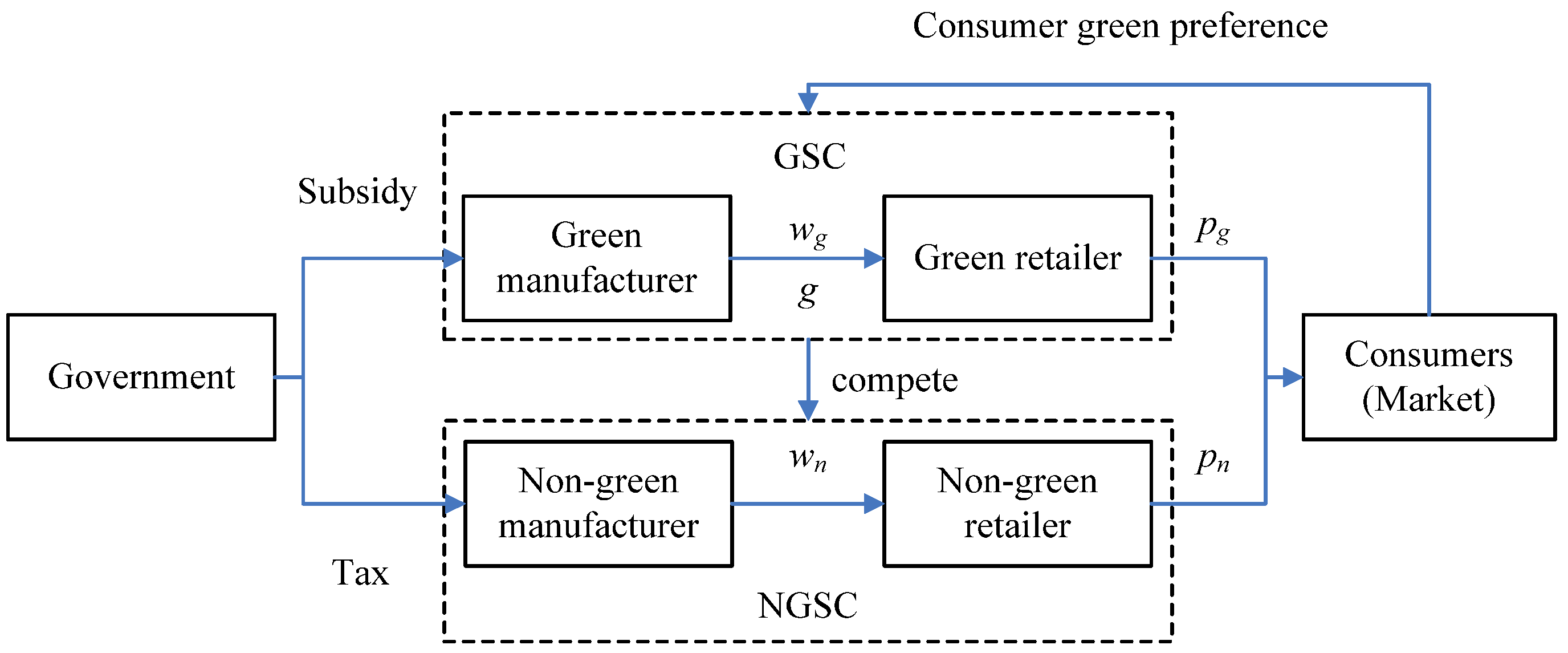

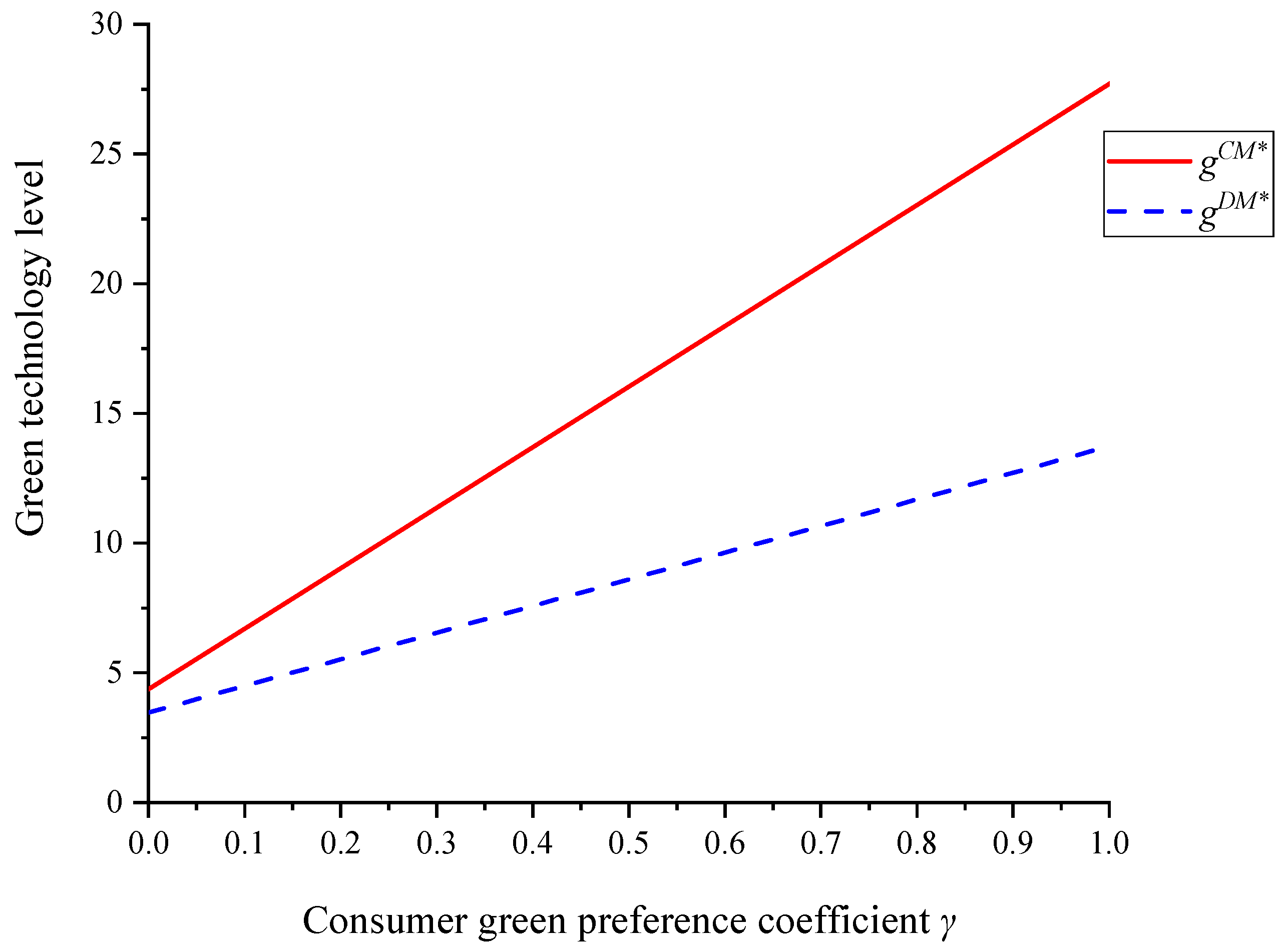
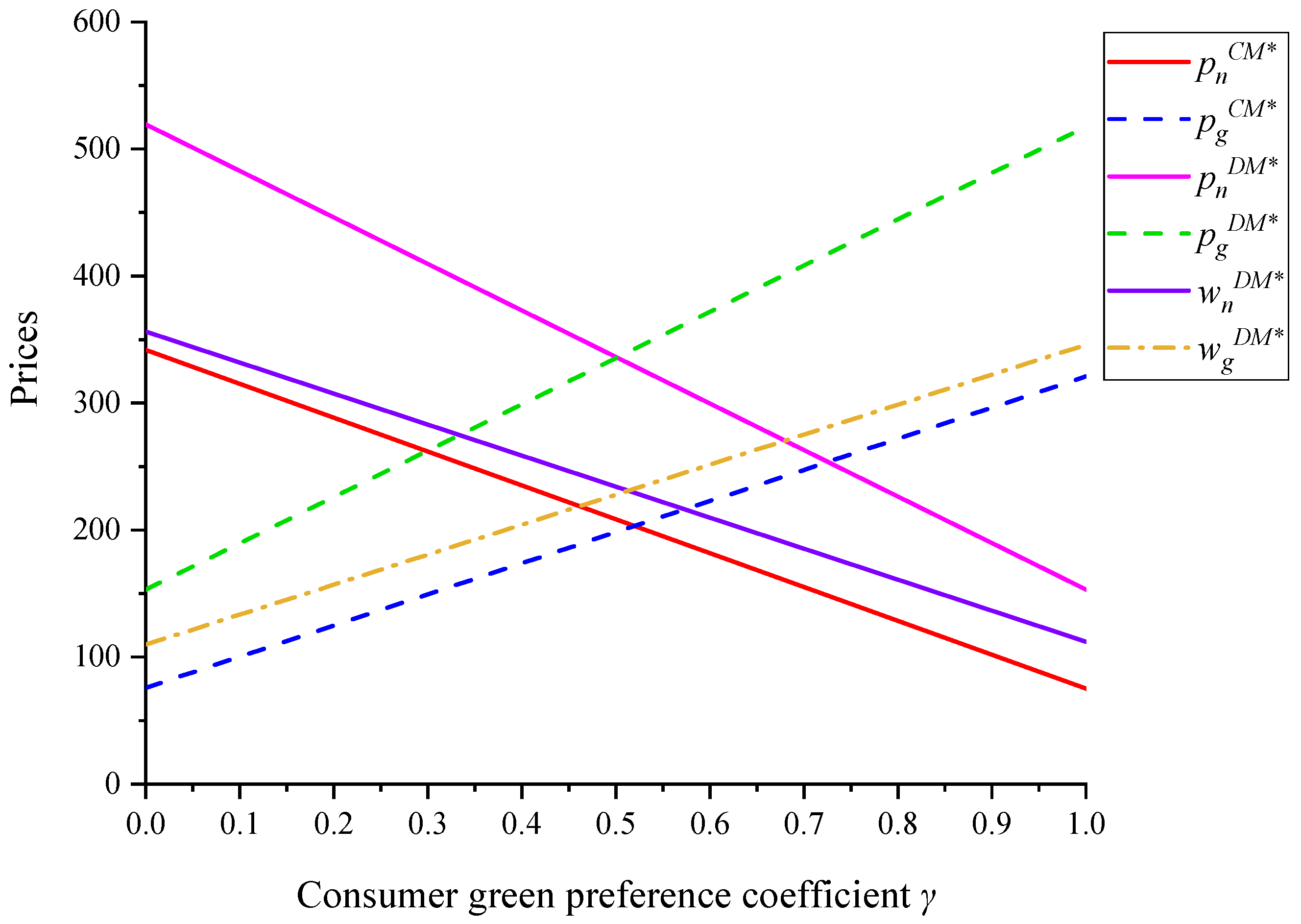

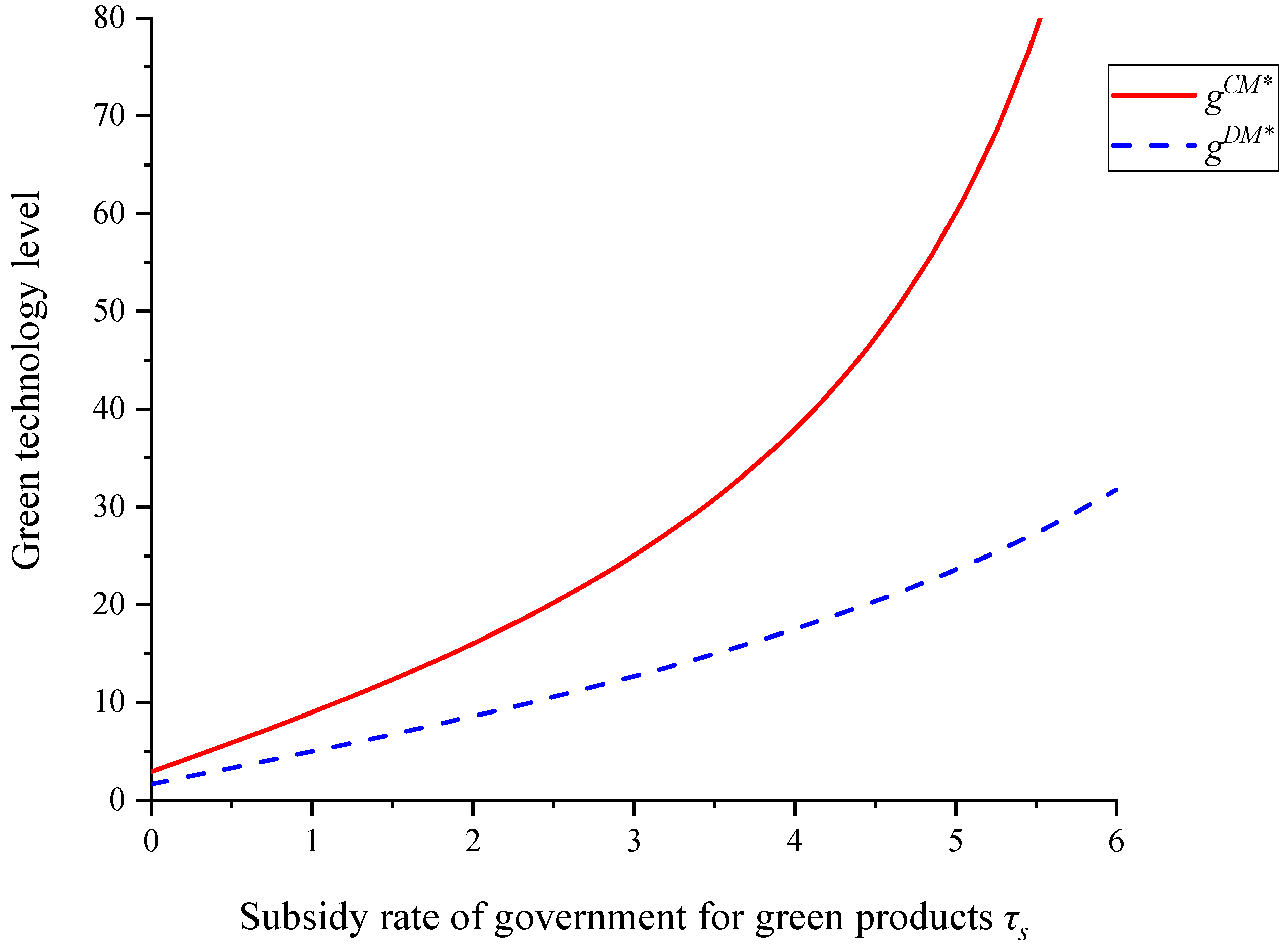

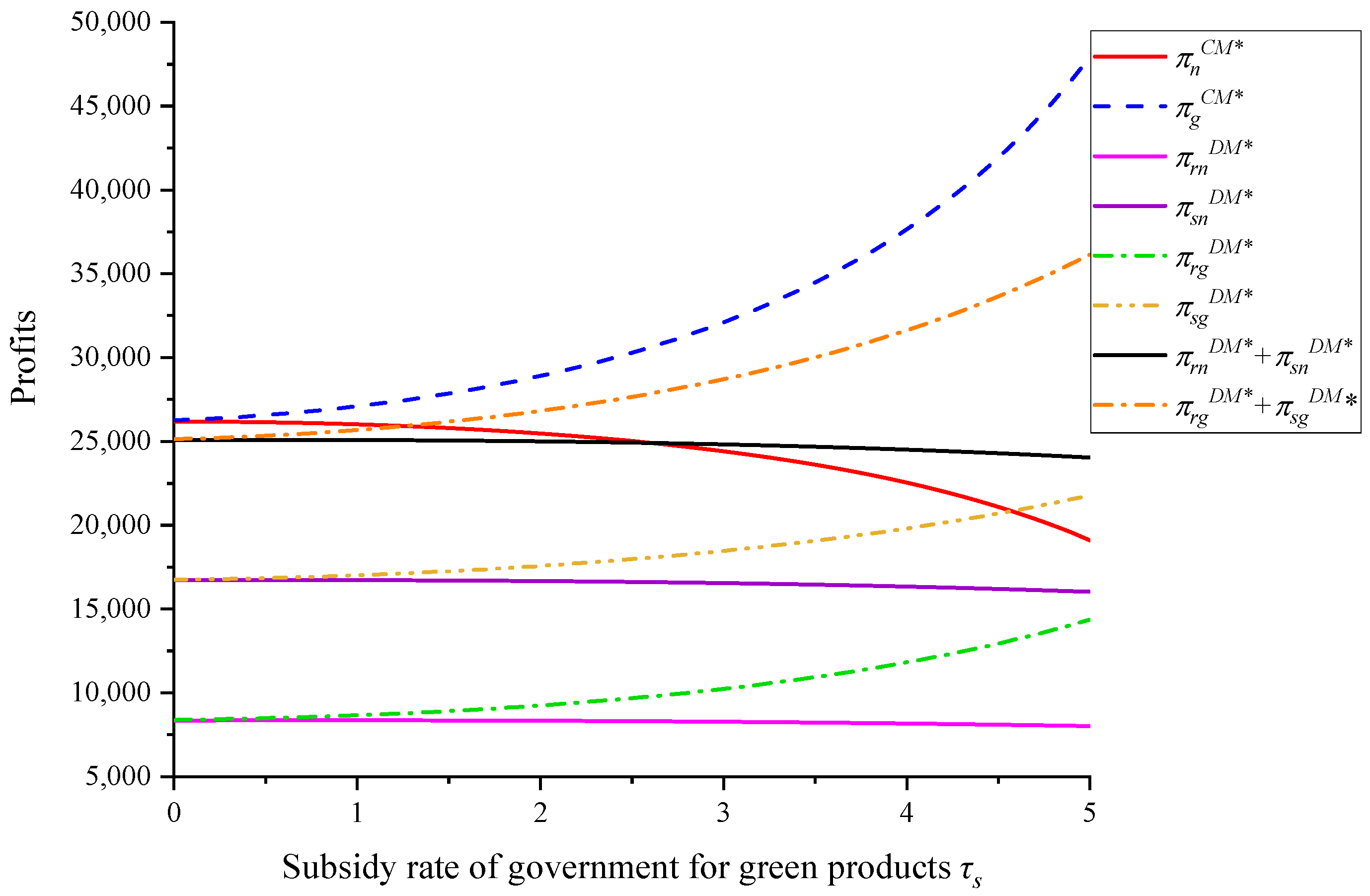
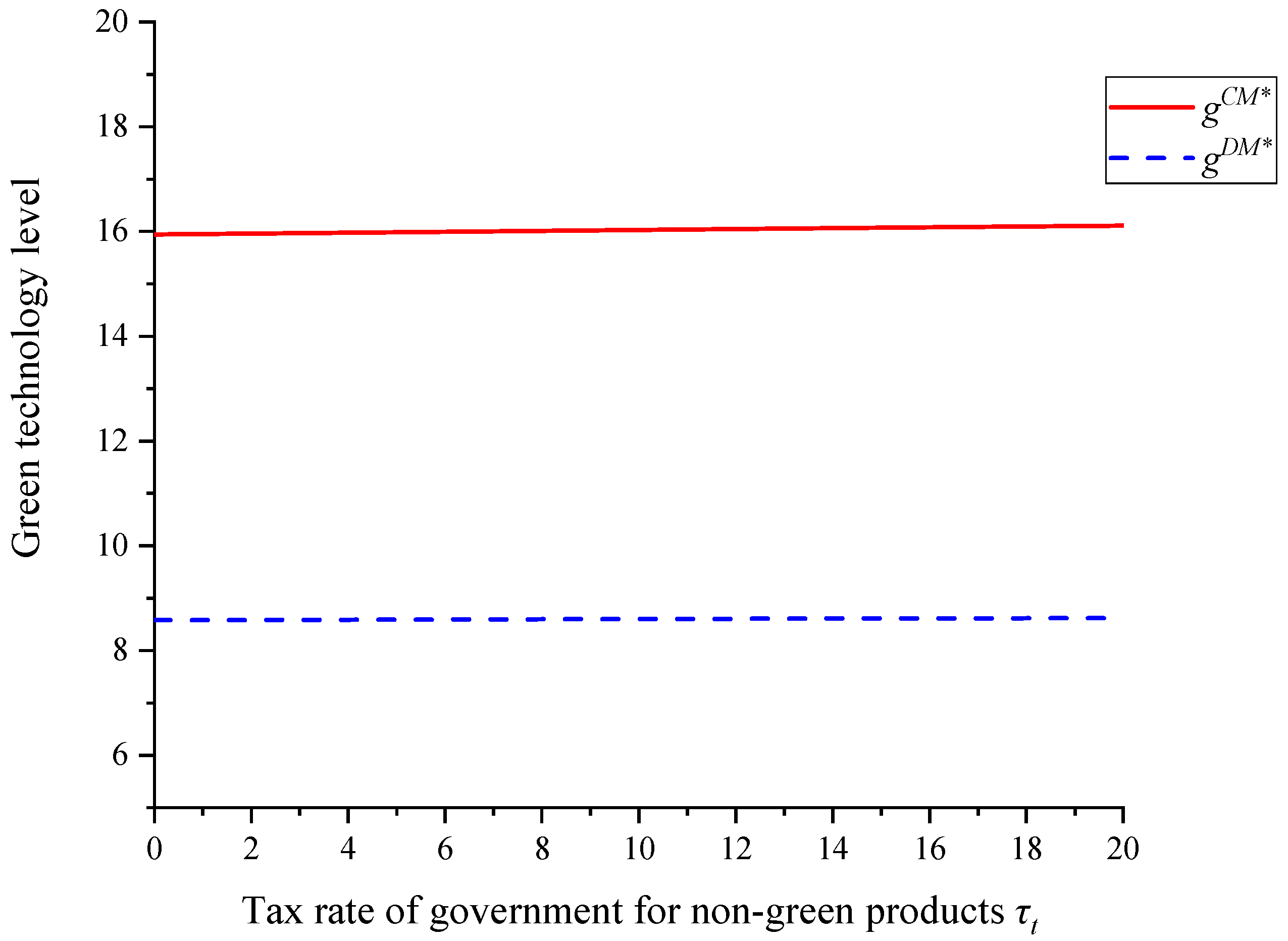
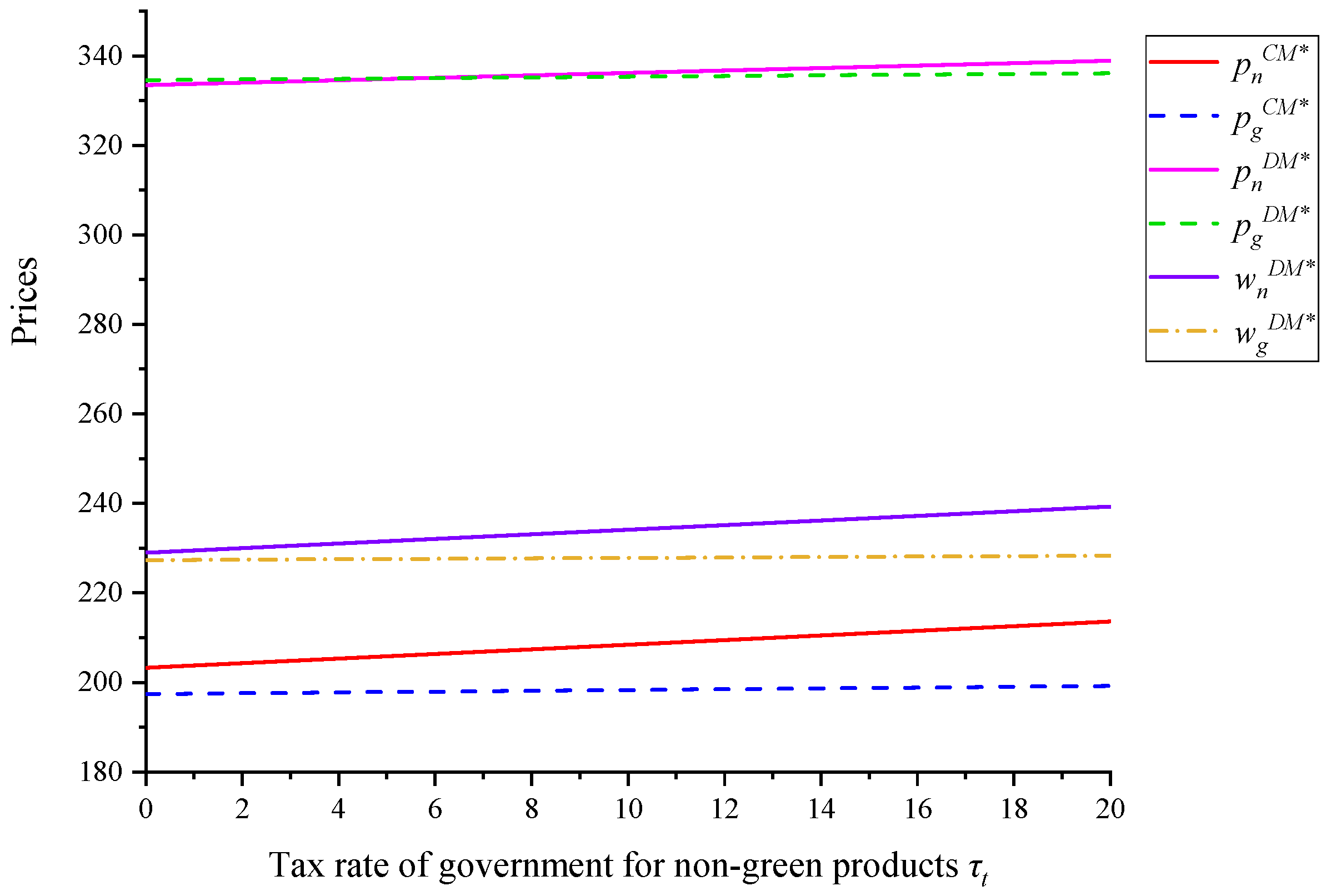


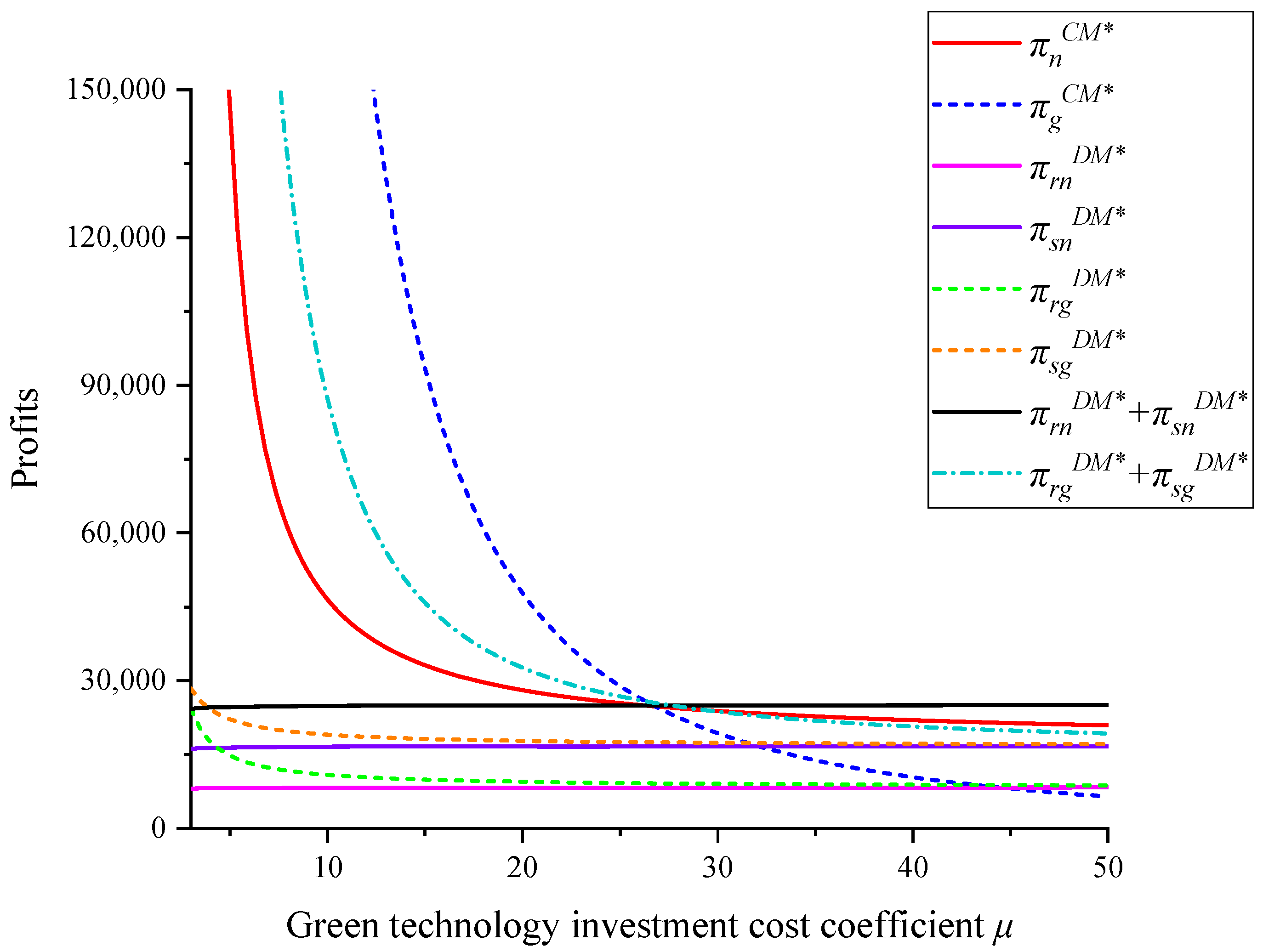
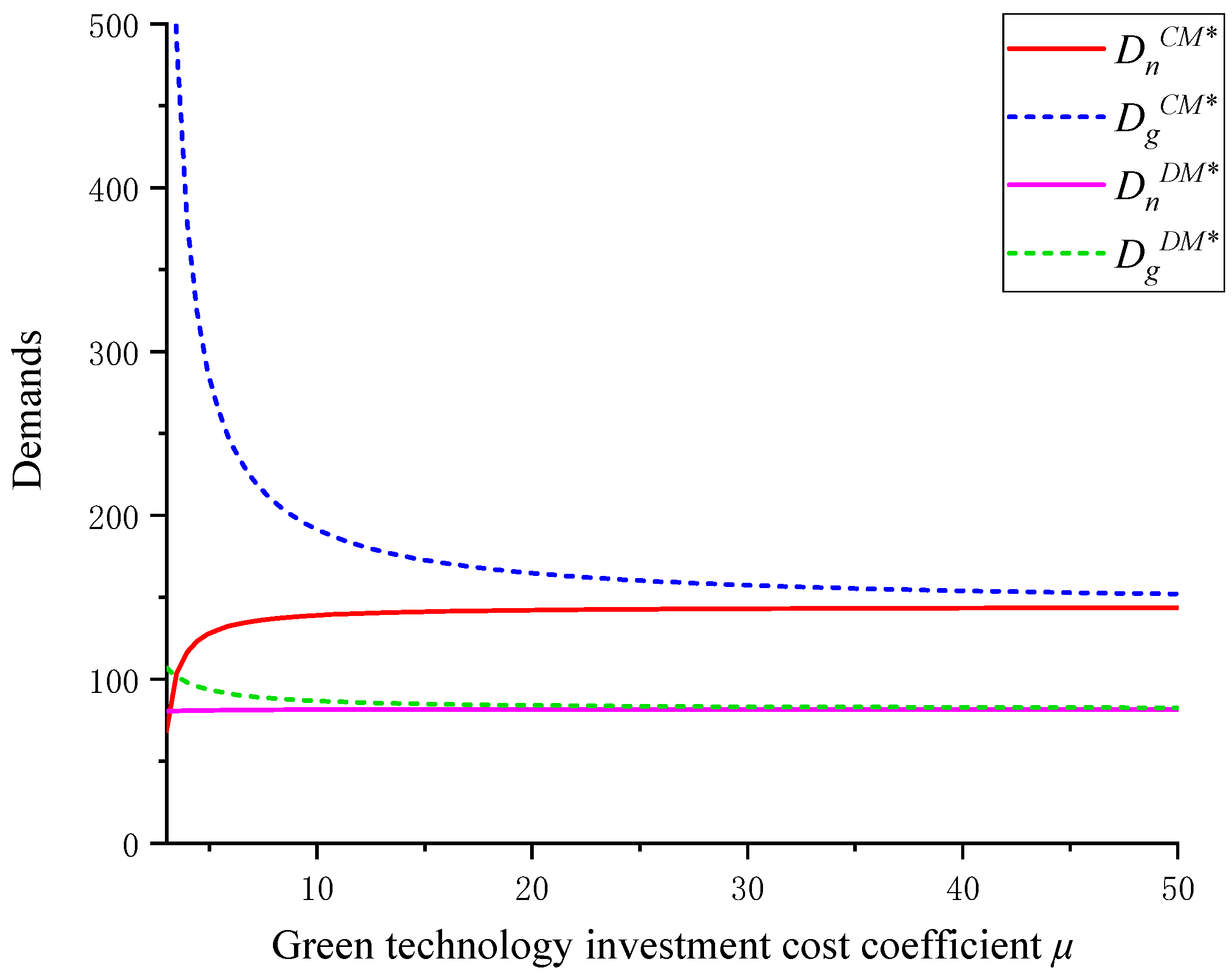
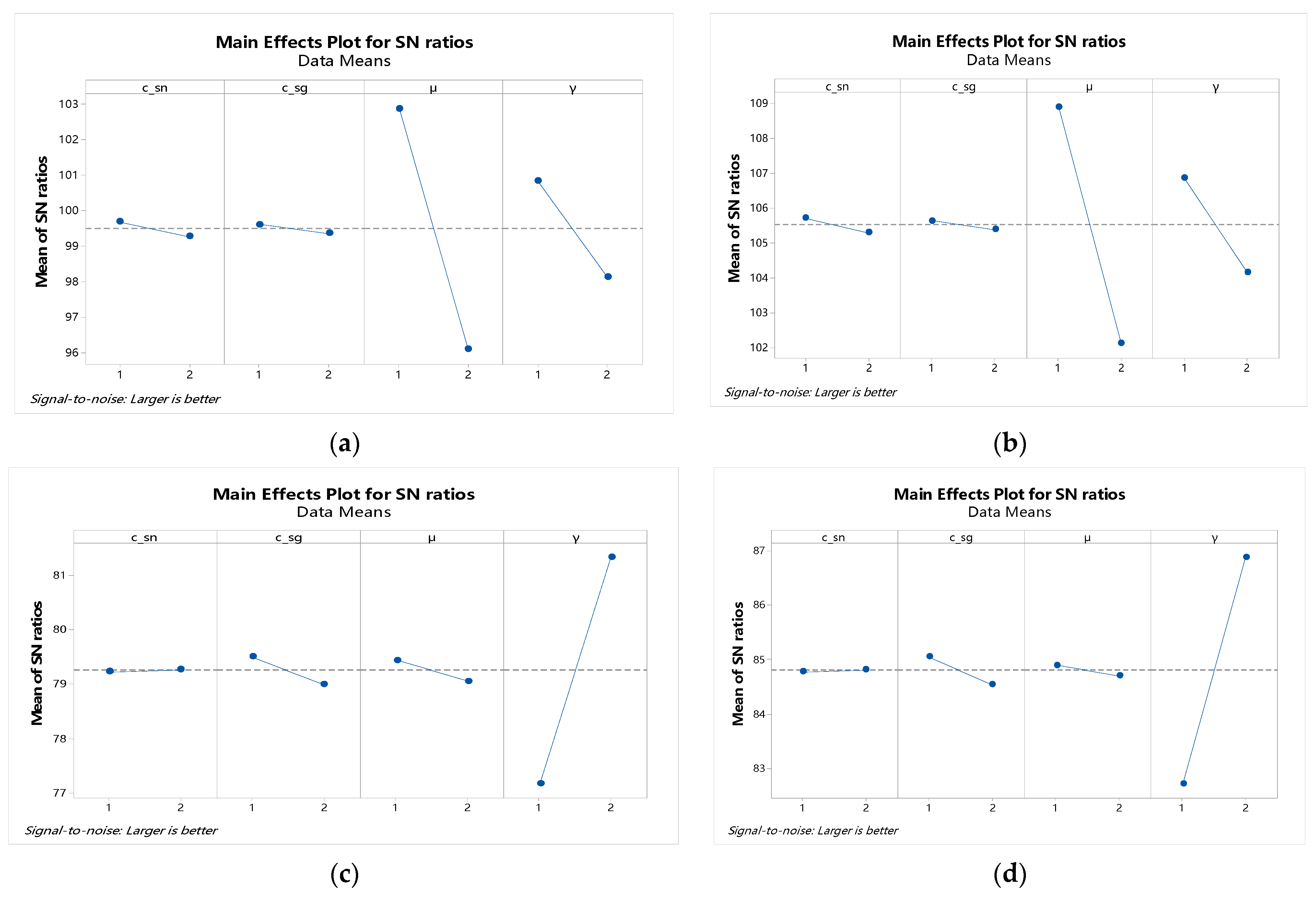
| Articles | Research Object | Government Interventions | Consumers Preferences | Sensitivity Analysis | The Stackelberg Leader |
|---|---|---|---|---|---|
| Hafezalkotob and Hadi [39] | A closed-loop supply chain and an ordinary supply chain | Government tariffs | None | The government | |
| Mahmoudi and Rasti-Barzoki [31] | A population of producers and a population of retailers in a specific industry | Taxes and subsidies | The sensitivity analysis of a single parameter | The government | |
| Sana [33] | Two firms produce green and nongreen products | A subsidy and tax | Numerical example | None | |
| Tong et al. [2] | A retailer-led supply chain | A cap-and-trade policy | √ | None | Retailers |
| Yang and Xiao [62] | A green supply chain | Subsidy or punishment | The sensitivity analysis of a single parameter | The manufacturer or the retailer | |
| Hadi et al. [41] | Regular and closed-loop SCs | Government tariffs | The sensitivity analysis of a single parameter | Two suppliers | |
| Yazdanpanah et al. [42] | A green SC and an ordinary supply chain | Tax rates and incentives | The sensitivity analysis of a single parameter | The government | |
| Hafezalkotob [44] | GSCs and NGSCs | Direct tariffs and tradable permits | Numerical example | The government | |
| Hafezalkotob [40] | A green supply chain and a regular supply chain | Government tariffs | Numerical example | The government | |
| Hafezalkotob et al. [45] | A green supply chain and a regular supply chain | A subsidy and tax strategies | The sensitivity analysis of a single parameter | The government | |
| Meng et al. [22] | A dual-channel green supply chain | Government subsidies | √ | The sensitivity analysis of a single parameter | The manufacturer |
| Feng et al. [26] | A multilevel closed-loop supply-chain system | Reward-and-punishment measures | √ | The sensitivity analysis of a single parameter | A manufacturer |
| This paper | An NGSC and a GSC | Subsidies or taxes | √ | The sensitivity analysis of a single parameter, and the robust sensitivity analysis of multiparameter | The manufacturer |
| No. | μ | γ | 1 | 1 | 2 | 2 | S/N Ratios | |||
|---|---|---|---|---|---|---|---|---|---|---|
| 1 | 2 | 1 | 2 | |||||||
| Response Values | ||||||||||
| 1 | 1 | 1 | 1 | 1 | 165,875.58 | 162,777.82 | 179,388.68 | 176,027.97 | 104.64 | |
| 2 | 1 | 1 | 1 | 1 | 331,751.16 | 325,555.65 | 358,777.36 | 352,055.95 | 110.66 | |
| 3 | 1 | 1 | 1 | 1 | 7294.43 | 7310.71 | 7933.53 | 7951.24 | 77.62 | |
| 4 | 1 | 1 | 1 | 1 | 13,945.50 | 13,976.62 | 14,532.64 | 14,565.08 | 83.07 | |
| 5 | 1 | 1 | 2 | 2 | 56,560.20 | 54,979.48 | 59,261.91 | 57,598.61 | 95.12 | |
| 6 | 1 | 1 | 2 | 2 | 113,120.40 | 109,958.96 | 118,523.83 | 115,197.22 | 101.14 | |
| 7 | 1 | 1 | 2 | 2 | 11,361.62 | 11,381.63 | 12,000.96 | 12,022.09 | 81.35 | |
| 8 | 1 | 1 | 2 | 2 | 22,055.18 | 22,094.02 | 22,656.21 | 22,696.10 | 86.99 | |
| 9 | 1 | 2 | 1 | 2 | 118,464.83 | 115,068.93 | 127,779.96 | 124,100.98 | 101.66 | |
| 10 | 1 | 2 | 1 | 2 | 236,929.66 | 230,137.86 | 255,559.91 | 248,201.96 | 107.68 | |
| 11 | 1 | 2 | 1 | 2 | 11,130.51 | 11,150.62 | 12,105.70 | 12,127.57 | 81.29 | |
| 12 | 1 | 2 | 1 | 2 | 21,279.31 | 21,317.75 | 22,175.23 | 22,215.29 | 86.74 | |
| 13 | 1 | 2 | 2 | 1 | 72,664.38 | 71,372.53 | 76,336.53 | 74,975.24 | 97.36 | |
| 14 | 1 | 2 | 2 | 1 | 145,328.77 | 142,745.07 | 152,673.05 | 149,950.47 | 103.38 | |
| 15 | 1 | 2 | 2 | 1 | 6630.92 | 6646.21 | 7004.05 | 7020.20 | 76.67 | |
| 16 | 1 | 2 | 2 | 1 | 12,871.94 | 12,901.62 | 13,222.71 | 13,253.20 | 82.32 | |
| 17 | 2 | 1 | 1 | 2 | 113,409.56 | 109,980.81 | 122,276.05 | 118,562.30 | 101.27 | |
| 18 | 2 | 1 | 1 | 2 | 226,819.13 | 219,961.62 | 244,552.10 | 237,124.60 | 107.29 | |
| 19 | 2 | 1 | 1 | 2 | 11,754.52 | 11,775.18 | 12,784.39 | 12,806.86 | 81.76 | |
| 20 | 2 | 1 | 1 | 2 | 22,472.29 | 22,511.79 | 23,418.44 | 23,459.60 | 87.22 | |
| 21 | 2 | 1 | 2 | 1 | 73,057.80 | 71,705.91 | 76,736.23 | 75,311.82 | 97.40 | |
| 22 | 2 | 1 | 2 | 1 | 146,115.60 | 143,411.82 | 153,472.46 | 150,623.64 | 103.42 | |
| 23 | 2 | 1 | 2 | 1 | 7107.06 | 7122.88 | 7506.98 | 7523.70 | 77.27 | |
| 24 | 2 | 1 | 2 | 1 | 13796.22 | 13,826.94 | 14,172.18 | 14,203.74 | 82.92 | |
| 25 | 2 | 2 | 1 | 1 | 153,318.60 | 150,436.08 | 165,800.03 | 162,672.88 | 103.96 | |
| 26 | 2 | 2 | 1 | 1 | 306,637.21 | 300,872.17 | 331,600.06 | 325,345.75 | 109.98 | |
| 27 | 2 | 2 | 1 | 1 | 6867.67 | 6883.47 | 7469.38 | 7486.56 | 77.10 | |
| 28 | 2 | 2 | 1 | 1 | 13,129.62 | 13,159.82 | 13,682.41 | 13,713.88 | 82.55 | |
| 29 | 2 | 2 | 2 | 2 | 52,539.54 | 51,052.83 | 55,043.30 | 53,478.98 | 94.48 | |
| 30 | 2 | 2 | 2 | 2 | 105,079.09 | 102,105.65 | 110,086.59 | 106,957.97 | 100.50 | |
| 31 | 2 | 2 | 2 | 2 | 10,835.40 | 10,854.94 | 11,445.13 | 11,465.76 | 80.94 | |
| 32 | 2 | 2 | 2 | 2 | 21,033.69 | 21,071.61 | 21,606.87 | 21,645.83 | 86.58 | |
Publisher’s Note: MDPI stays neutral with regard to jurisdictional claims in published maps and institutional affiliations. |
© 2022 by the authors. Licensee MDPI, Basel, Switzerland. This article is an open access article distributed under the terms and conditions of the Creative Commons Attribution (CC BY) license (https://creativecommons.org/licenses/by/4.0/).
Share and Cite
Cheng, W.; Wu, Q.; Ye, F.; Li, Q. The Impact of Government Interventions and Consumer Green Preferences on the Competition between Green and Nongreen Supply Chains. Sustainability 2022, 14, 5893. https://doi.org/10.3390/su14105893
Cheng W, Wu Q, Ye F, Li Q. The Impact of Government Interventions and Consumer Green Preferences on the Competition between Green and Nongreen Supply Chains. Sustainability. 2022; 14(10):5893. https://doi.org/10.3390/su14105893
Chicago/Turabian StyleCheng, Wen, Qunqi Wu, Fei Ye, and Qian Li. 2022. "The Impact of Government Interventions and Consumer Green Preferences on the Competition between Green and Nongreen Supply Chains" Sustainability 14, no. 10: 5893. https://doi.org/10.3390/su14105893
APA StyleCheng, W., Wu, Q., Ye, F., & Li, Q. (2022). The Impact of Government Interventions and Consumer Green Preferences on the Competition between Green and Nongreen Supply Chains. Sustainability, 14(10), 5893. https://doi.org/10.3390/su14105893






